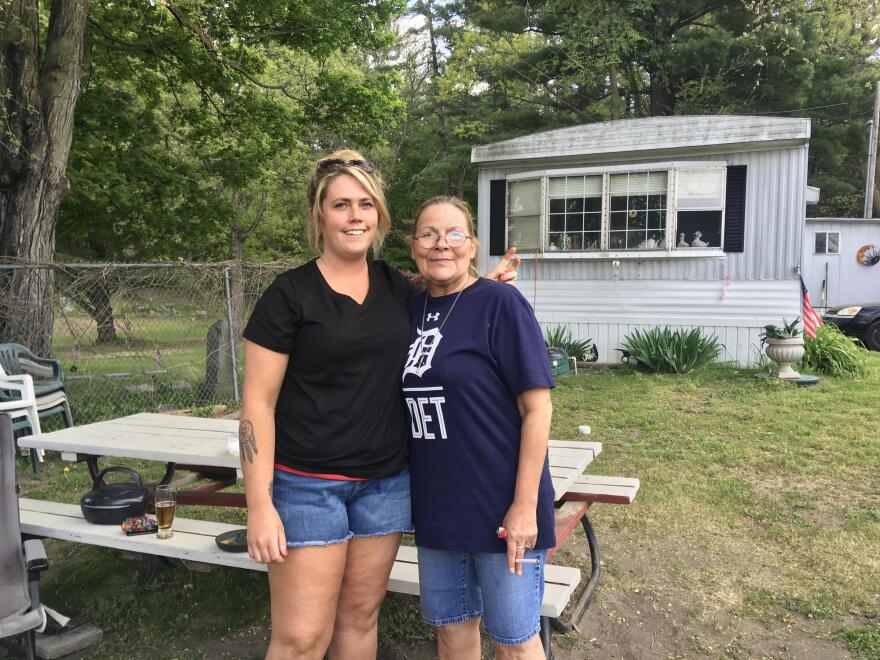One year after the dam failures on the Tittabawassee River that forced the evacuation of mid-Michigan communities and submerged homes and businesses, the recovery is finally becoming tangible.
In Sanford, a village of about 800 people, the local government said the flood wiped out more than three-quarters of its businesses and 10% of its homes.
But now, two village staples have reopened: the Red Oak Family Restaurant and the local hardware store.
Denny Sian, the owner of Sanford Hardware, said the community supported his business while it operated out of a small, temporary space.
“We’ve been working hard for almost a year to get open, and now we’ve got a brand new store, and you can see it’s beautiful,” Sian said.
He’s kept photos of the flood damage that he displays behind the counter in a wooden frame made by his daughter.
The words that she’s etched into the wood make Sian “more proud than anything in here,” he said: “We rise by lifting others. … It is only because you were there for us that we are here to serve you today.”
Sian said customers donated money, time and supplies to help rebuild the store, and this week there was a steady stream of them coming through the door to buy from him again.
One of the customers was Carl Hamann, a Sanford village council member.
“We’re painting some cabinets and doing some stuff at home, so this is where we spend our money,” he said. “I think a lot of people are doing that.”
But not everything in Sanford has been rebuilt.

Battered playground equipment still lies strewn across what used to be a riverside park. The earthen embankments that held in the Tittabawassee River and created Sanford Lake are still gaping open, allowing the river to flow unimpeded. Broken bits of boats and buildings still dot the dry lakebed in front of the homes of people who used to have lakefront property.
And some of Sanford’s past might never come back.

A small neighborhood on the south edge of the village was inundated by the floods, and now the federal government has said the risk of another flood is so high that the homes will not be rebuilt.
In their place, Teresa Quintana, a local realtor and nonprofit leader, has been working to create a new park.
The space has been named Porte Park, after Dolores Porte, the village president, who Quintana said has ably shepherded the local community through the uncertainty that came after the floods..
For the park, Quintana is envisioning playground equipment, live music and sports fields. But that’s likely still at least a few months away. Right now, all she can boast about the park is its quickly growing grass.
“I have this weird thing where I kind of drive through here a couple times a week to check on the grass, and I always laugh. I’m, like, turning into this, you know, middle-aged man that’s obsessed with his lawn!” she said.

Quintana said even her relentlessly positive personality was subject to moments of despair over the last year. But now, with the park taking shape and stores and restaurants reopening, the progress is visible. The village is starting to come back.
There’s so much going on,” she said. “It’s good. I think everyone in the community seems really excited about it.”
One of those excited people is Talena Odell, who, with her husband, runs a mobile home park across the street from the Sanford dam.
Odell said she fled the flood waters and returned a week later to a home with no electricity. The lights didn’t come on for almost a month, she said. “We sat and played cards,” she said. “That’s about it. Euchre, Spades, Canasta.”
She’s impressed by the village’s progress over the last year. “They’ve done so much. It’s amazing,” she said. “We didn’t have nothing … and now, it’s all coming back. It’s awesome.”

Porte, the village president, said she never lost faith in the community in the year since the flood, but navigating the administrative red tape in recovery efforts has been frustrating.
She said the local government had to provide a vast amount of information to federal authorities to get money for rebuilding. By way of example, she laid out some of the questions she remembered from the Federal Emergency Management Administration when the village was applying for funding to replace a clock sign that was swept away by flood waters.
“How big is the pad of cement that it’s on? How thick is the pad of cement it’s on? How big is the cover that’s on there? What was it made of before? Are you sure the clock worked before the flood, because we don’t pay for a clock that didn’t work before the flood. How can you prove the clock worked before the flood?” she recited.
Porte said it’s hard for small towns like Sanford to match the level of detail that the federal bureaucracy demands. “That was huge frustration. If I was able to testify in Washington, D.C. about anything, I’d say the FEMA process is unbelievably difficult.”
But, eventually, with the help of a federal project manager, Sanford answered the government’s questions, Porte said. The village got funding for rebuilding projects, and people whose homes were wiped out were starting to get reimbursed
Many of them said it’s not nearly enough to cover their losses, but this is their home, and they’re going to build it back.



